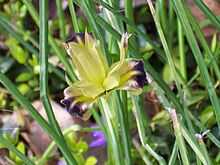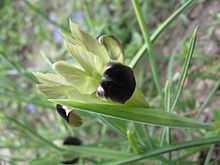Hermodactylus
{{taxobox |name =Hermodactylus |image =Hermodactylus tuberosus.jpg |image_caption =Hermodactylus tuberosus |regnum =Plantae |unranked_divisio =Angiosperms |unranked_classis =Monocots |ordo =Asparagales |familia =Iridaceae |subfamilia =Iridoideae |tribus =Irideae |genus =Hermodactylus |genus_authority =Mill.[1] |type_species =Hermodactylus tuberosus |type_species_authority =Mill.[2] Salisb. |subdivision_ranks =Species |subdivision =See text. |}}


Hermodactylus is a genus of non-rhizomatous plants of the family Iridaceae, consisting of a single species, Hermodactylus tuberosus. Common names include Snake's-head , Widow Iris, Black Iris, or Velvet Flower-de-Luce.
The genus name is derived from the Greek words meaning "Hermes' Finger" in reference to the knarled finger-like appearance of the tuberous bulb. Hermes was the messenger of the Gods in Greek Mythology.
Distribution
Native of the Mediterranean region, it is found in the northern Mediterranean littoral and western Europe. [3]
Cultivation
Grown from tuberous bulbs planted in the autumn. Hermodactylus grows best in full sun to partial shade, and requires well drained soil. In can naturalise in grassy areas bit grows well in rock gardens or containers. [4] It is a common ornamental garden plant, flowering in early spring.
Taxonomic history
After being split off from the genus Iris by the nineteenth century, as a separate genus, [5] Hermodactylus has most recently been returned to the genus Iris, [6] [7] following molecular studies at Kew [8] Hence its type genus is more properly described by its original name Iris tuberosa L., although still widely described as Hermodactylus tuberosus. According to the proposed molecular classification of iris of Tillie, Chase and Hall [8] this species is now best seen as a member of the subgenus Hermodactyloides, the reticulate-bulbed bulbous irises.
Species and infrageneric taxa
While six species have been described [9] [10] (see below) these are more properly considered variants of Iris tuberosa.
- Hermodactylus bispathaceus Sweet
- Hermodactylus calatajeronensis Tod. ex Lojac.
- Hermodactylus longifolius Sweet
- Hermodactylus repens Sweet
- Hermodactylus tuberosus (L.) Mill.
- Hermodactylus tuberosus subsp. longifolius (Sweet) K.Richt.
- Hermodactylus tuberosus var. longifolius (Sweet) Baker
- Hermodactylus zambranii Lojac.
The following are considered as Iris tuberosa var. tuberosa:
- Hermodactylus bispathaceus
- Hermodactylus calatajeronensis
- Hermodactylus repens
- Hermodactylus tuberosus
- Hermodactylus zambranii
while the remainder are allocated to Iris tuberosa var. longifolia
References
- ↑ ROYAL GENERAL BULBGROWERS' ASSOCIATION (K.A.V.B.)
- ↑ GBIF: Hermodactylus tuberosus
- ↑ Schede di botanica : Hermodactylus tuberosus (L.) Salisb.
- ↑ Paghat's Garden Paghat's Garden: Snake's-head or Widow Iris
- ↑ David Joyce: The Genus Iris
- ↑ Pacific Bulb Society
- ↑ "{{subst:PAGENAME}}". Royal Botanic Gardens, Kew: World Checklist of Selected Plant Families. Retrieved 3 sep 2011.
- ↑ 8.0 8.1 Tillie N, Chase MW, Hall T. 2002 Molecular studies in the genus Iris L.: a preliminary study. Ann. Bot. n.s. (Italy) 1. (2): 105-112 (2001)
- ↑ The International Plant Names Index
- ↑ INPN
Bibliography
- Telegraph: How to grow Hermodactylus
- Manning, John; Goldblatt, Peter (2008). The Iris Family: Natural History & Classification. Portland, Oregon: Timber Press. pp. 204–207. ISBN 0-88192-897-6.
- Goldblatt, P., (1990) Phylogeny and classification of Iridaceae. Ann. Missouri Bot. Gard. 77:607-627.
- Reeves, G., Chase, M.W., Goldblatt, P., Rudall, P., Fay, M.F., Cox, A.V., LeJeune, B., & Souza-Chies, T., (2001). Molecular systematics of Iridaceae: Evidence from four plastid DNA regions. Amer. J. Bot. 88:2074-2087.
- Iridaceae: in L. Watson and M.J. Dallwitz (1992 onwards). The families of flowering plants: descriptions, illustrations, identification, information retrieval
| Wikimedia Commons has media related to Hermodactylus. |
| Wikispecies has information related to: Hermodactylus |